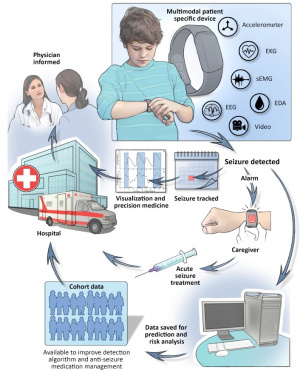Difference between revisions of "Deep neural networks for seizure detection"
From iis-projects
| (9 intermediate revisions by 3 users not shown) | |||
| Line 1: | Line 1: | ||
| − | |||
[[File:Non-EEG Seizure.jpg|thumb|300px]] | [[File:Non-EEG Seizure.jpg|thumb|300px]] | ||
==Description== | ==Description== | ||
| Line 9: | Line 8: | ||
1 - Development in a high-level programming language (python) of different deep learning algorithms for time series classification. In particular, the initial targets will be the InceptionTime, the MultiScale-CNN, the Temporal Convolutional Networks, and a bidirectional LSTM. | 1 - Development in a high-level programming language (python) of different deep learning algorithms for time series classification. In particular, the initial targets will be the InceptionTime, the MultiScale-CNN, the Temporal Convolutional Networks, and a bidirectional LSTM. | ||
| − | 2 - Benchmarking of these algorithms on a large - scale dataset collected by the Bern | + | 2 - Benchmarking of these algorithms on a large-scale dataset collected by the Bern Inselspital about epileptic patients [4]. |
| + | |||
3 - Comparison with state of the art methods (Local Binary pattern + Hyperdimensional computing [5], Short-time Fourier transform + Convolutional Neural Networks and classical machine learning methods). | 3 - Comparison with state of the art methods (Local Binary pattern + Hyperdimensional computing [5], Short-time Fourier transform + Convolutional Neural Networks and classical machine learning methods). | ||
| − | 4 - Characterization of the algorithm on different computing platforms, from the high-level number of operations to the number of cycles and energy consumption on embedded devices (e.g. GAP8, a | + | 4 - Characterization of the algorithm on different computing platforms, from the high-level number of operations to the number of cycles and energy consumption on embedded devices (e.g. GAP8, a multi-core chip from GreenWaves Technology). |
| − | ===Status: Available === | + | ===Status: Currently Not Available === |
Looking for one student for Master's thesis. | Looking for one student for Master's thesis. | ||
| − | : Supervision: | + | : Supervision: [[:User:xiaywang|Xiaying Wang]], [mailto:alessio.burrello@unibo.it Alessio Burrello] |
===Prerequisites=== | ===Prerequisites=== | ||
| Line 79: | Line 79: | ||
[[#top|↑ top]] | [[#top|↑ top]] | ||
| + | |||
| + | [[Category:Digital]][[Category:Semester Thesis]] [[Category:NotAvailable]] [[Category:2020]][[Category:Hot]][[Category:Human Intranet]][[Category:xiaywang]][[Category:Epilepsy]][[Category:EmbeddedAI]] | ||
<!-- | <!-- | ||
| Line 114: | Line 116: | ||
---> | ---> | ||
| − | |||
| − | |||
Latest revision as of 20:02, 10 March 2024
Contents
Description
Epilepsy is one of the most prevalent chronic neurological disorders. One-third of patients with epilepsy continue to suffer from seizures despite pharmacological therapy. For these patients with drug-resistant epilepsy, efficient algorithms for seizure detection are needed in particular during pre-surgical monitoring. Many efforts have been pursued in this direction with the fabrication of many ASIC and the development of advanced machine/deep-learning to optimize both the energy efficiency for years-operating devices and the accuracy in the epilepsy detection. In terms of time-series analysis, a big variety of deep-learning approaches are arising for efficient processing such as InceptionTime [1], MultiScale-CNN [2], and Temporal Convolutional Networks (TCN) [3].
The thesis would be a 6-month full-time project with the following steps to accomplish:
1 - Development in a high-level programming language (python) of different deep learning algorithms for time series classification. In particular, the initial targets will be the InceptionTime, the MultiScale-CNN, the Temporal Convolutional Networks, and a bidirectional LSTM.
2 - Benchmarking of these algorithms on a large-scale dataset collected by the Bern Inselspital about epileptic patients [4].
3 - Comparison with state of the art methods (Local Binary pattern + Hyperdimensional computing [5], Short-time Fourier transform + Convolutional Neural Networks and classical machine learning methods).
4 - Characterization of the algorithm on different computing platforms, from the high-level number of operations to the number of cycles and energy consumption on embedded devices (e.g. GAP8, a multi-core chip from GreenWaves Technology).
Status: Currently Not Available
Looking for one student for Master's thesis.
- Supervision: Xiaying Wang, Alessio Burrello
Prerequisites
- Machine Learning
- Python & C Programming
Character
- 20% Theory
- 80% Programming
Professor
Literature
- H. I. Fawaz et al., InceptionTime: Finding AlexNet for Time Series Classification [1]
- Z. Cui et al., Multi-Scale Convolutional Neural Networks for Time Series Classification [2]
- C. Lea et al., Temporal Convolutional Networks: A Unified Approach to Action Segmentation, [3]
- iEEG-SWEZ data base [4]
- A. Burello et al., Laelaps: An Energy-Efficient Seizure Detection Algorithm from Long-term Human iEEG Recordings without False Alarms [5]
